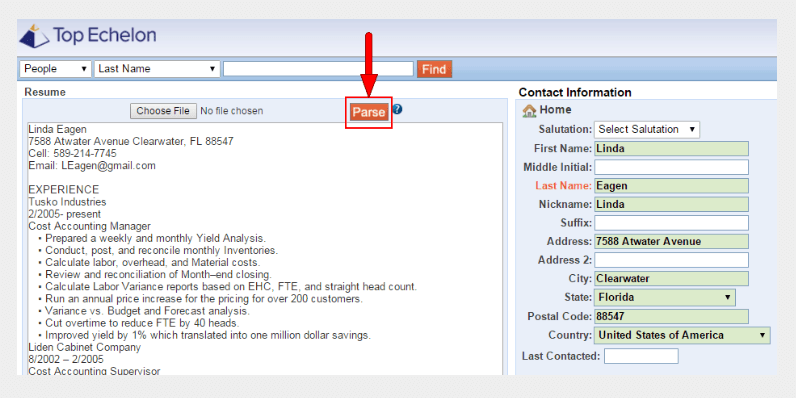Many recruiters use recruiting software to speed up the job placement process for their clients. With the help of software, recruiters don’t need to sift through resumes and waste time on unqualified candidates. One feature of recruiting software is resume parsing. What is resume parsing?
What is resume parsing?
Resume parsing (CV parsing, resume extraction) is the process of importing resumes into your recruiting software, extracting information so all resumes are formatted the same way, and organizing them by keyword.
Some recruiting software services also offer email parsing, which gives an added bonus to the resume parsing. With email parsing, you can email resumes to your recruiting database. The software parses the resume, creates a record, and attaches the resume to that record.
Benefits of resume parsing
Resume extraction can save recruiters significant time. Instead of reading through stacks of resumes, the CV parsing software extracts the information you need. That way, you can easily compare applicants to find qualified candidates. No more coding resumes and manually organizing them with applicant tracking spreadsheets.
You can also save time in your future job placements. With resume extraction software, you won’t lose track of qualified candidates. Simply enter keywords for the position and see all the resumes in your applicant tracking database with those keywords.
For example, you have a new job placement order for an accounting firm looking for a certified public accountant (CPA). You know there are a few resumes in your database for CPAs. When you search “CPA” in your database, you have access to all those candidates. That way, you don’t have to work as hard sourcing new candidates and can save time comparing them.
Many resume parsing systems also support different languages. Let’s say you are a bilingual recruiter with clients who speak English and clients who speak French. Some clients need to find English-speaking candidates, and others need to find French-speaking candidates. A multilingual resume parsing system can handle both.
Resume parsing techniques
So, how does resume parsing software work?
You might receive resumes via email, mail, or a job posting service. Many resumes are created with Microsoft Word. If you receive a hard copy of a resume, simply scan it onto your computer and save it as a file. Your recruiting software can import resumes from files into your database.
When you receive resumes from applicants, your recruiting software might need to convert them to plain text. Once the resumes are in plain text, the resume parsing algorithm extracts information. The parser then produces a new document in a uniform format.
After resume parsing is complete, the software ranks candidates based on how closely they match the keywords or profiles of the job you are searching for.
Many resume parsing tools give you the opportunity to customize the parsing feature to match your needs. You can choose what you are searching for, like education levels, skill sets, or experience. For example, if you need an employee with over five years of experience, you can change the setting on the recruiting software to reflect that.
Job description and resume parsing
The job description for the position should mirror the resume parsing techniques. The keywords included in the job description will be the same keywords the resume parser will look for.
For example, the job description might include information like the following:
- Must be certified in risk and information systems control (CRISC)
- Must have a Ph.D. in Information Technology
The resume parser then focuses on resumes with CRISC and Ph.D. in Information Technology listed on it.
Resume parsing example
All resumes look different. Besides the fact that working individuals have different skills, education, experience, and career objectives, people set up their resumes differently. But with resume parsing, all candidate information can be arranged in the same format.
Here is an example of what resume parsing looks like:
As you can see on the left, the candidate’s resume (in plain text) is parsed into a standard format on the right.
Here is another example of a candidate’s resume that has been parsed:
The two resumes are set up differently from one another. Through the resume parsing, you can compare information in a simple format, instead of reading through mounds of text.
Looking for recruiting software with a resume parsing feature? Top Echelon’s Big Biller Recruiting Software combines an applicant tracking system with a recruiting CRM to streamline your recruiting process. Try it for free today!









